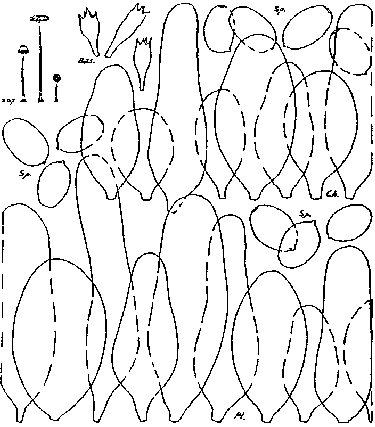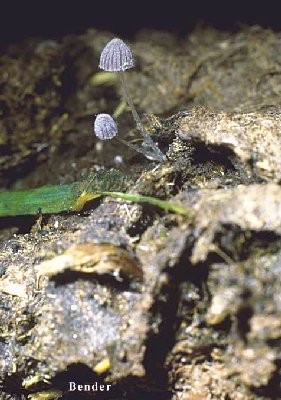Macroscopic features |
Closed pileus ellipsoid to cylindrical-ellipsoid, up to 5 x 3 mm, expanding up to 7 mm broad, in buds dark grey or mouse-grey, becoming paler with age, entirely powdery but at margin somewhat hairy-floccose. Lamellae, L = 8-16, l = 0-1, free, rather distant, first white but soon grey to spotted blackish. Stipe up to 20 x 0.5 mm, vitreous, subbulbous at base. Smell absent. |
Microscopic features |
Spores [140,7,6] 6.3-10.3 x 3.8-6.2 µm, Q = 1.34-1.95, av. Q = 1.55-1.80, av. L = 7.4-9.3, av. B = 4.5-5.7 µm, cylindrico-ellipsoid, ellipsoid or ovoid, red-brown under microscope, with central, 1.3 µm wide germ pore. Basidia 12-28 x 7-9 µm, 4-spored, surrounded by (3-)4-5(-6) pseudoparaphyses. Pleurocystidia 50-120 x 21-38 µm, ellipsoid, utriform or subcylindrical. Cheilocystidia 40-90 x 18-32 µm, similar to pleurocystidia. Pileipellis consisting of roundish elements covered by narrow hyphae, passing upwards into velar tissue. Velar elements (sub)globose to ellipsoid, up to 50 µm wide, connected by 10-75 µm long and 3-7 µm wide, cylindrical, sometimes fusiform hyphae, hyaline, greyish in part, thin-walled, granular. Velum at margin of pileus and on stipe made up of cylindrical to fusiform or clavate elements for the most part. Clamp-connections absent. |
Habitat & distribution |
Solitary or in groups; on pure dung, especially of cow. |
Remarks |
The type of C. poliomallus is lost (H. Romagnesi pers. comm.) Therefore, coll. Uljé 1181 is selected here as neotype. |

[Copyright © by ]

[Copyright © by Hans Bender jbe8995374@aol.com]